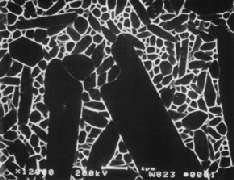Debate:
Does Fracture Mechanics Apply to Design of Structural
Ceramics?
Moderators: Ronald Kerans, Wright-Patterson; Rowland Cannon, Lawrence
Berkeley Lab
Debators: Tony Evans, Princeton; Edwin R. Fuller, NIST, Brian Cox,
Rcokwell, and Peter Gumbsch
Background
As a scientific and technical community, we have made great
progress in the development of tough ceramics. We now understand the
basic principles of how microstructural mechanisms give rise to
toughness and, in fact, select and design structural materials on the
basis of their microstructure. Our understanding derives from fracture
mechanics.
Although we employ fracture mechanics models for prediction, the models
only remotely, if at all, resemble the microstructures of real
materials.
For instance, this is how cracks are described in fracture mechanics
textbooks:
And this is kind of microstructure that we apply such calculations to:
 Two phase, anisotropic, highly irregular microstructures, lots of
defects, etc.
Two phase, anisotropic, highly irregular microstructures, lots of
defects, etc.
-
Why should such simple models give us any
insight at all into the behavior of structural ceramics?
-
Is a more realistic model possible? If we had
a realistic model, would it be more useful than our current
understanding of fracture mechanics?
-
There are many examples in science of the
utility of overly simple (and incorrect) models which give us
extraordinary insight into complex physical phenemona---for instance,
the Bohr Atom. Is this the case for our applications of fracture
mechanics?
Debate Format:
-
Each of the moderators will have 10 minutes. One will make the argument
that "Fracture Mechanics suffices for the purposes of
understanding how complex microstructures give rise to observed
strength and toughness behavior", and the other will argue that
"An entirely new model is required, which handles the complexities
of microstructures, to truly develop a predictive model."
-
Each of the Debators will talk for 15 minutes each, articulating their
particular viewpoint of the question
-
The Panel moderators will phrase questions (prepared in advance from
the electronic forum) and the debators will respond for less than 5
minutes. The debators will know the questions prior to the debate.
-
Questions will be taken from the audience and the moderators will lead
the discussion
-
Each of the debators will have 5 minutes to sum up.
-
We will retire to an environment which lends itself to further debate.






![]() Two phase, anisotropic, highly irregular microstructures, lots of
defects, etc.
Two phase, anisotropic, highly irregular microstructures, lots of
defects, etc.